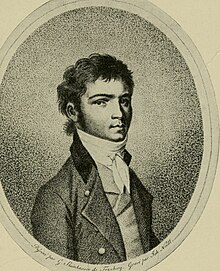Piano Trios, Op. 1 (Beethoven)
| Piano Trios | |
|---|---|
| by Ludwig van Beethoven | |
 The earliest known portrait of Beethoven; 1801 engraving by Johann Joseph Neidl after a now-lost portrait by Gandolph Ernst Stainhauser von Treuberg, ca. 1800 | |
| Key | |
| Opus | 1/1–3 |
| Dedication | Prince Lichnowsky |
| Performed | 1795: Vienna |
Ludwig van Beethoven's Opus 1 is a set of three piano trios (written for piano, violin, and cello), first performed in 1795 in the house of Prince Lichnowsky, to whom they are dedicated.[1] The trios were published in 1795.
Despite the Op. 1 designation, these trios were not Beethoven's first published compositions;[2] this distinction belongs rather to his Dressler Variations for keyboard (WoO 63). Clearly he recognized the Op. 1 compositions as the earliest ones he had produced that were substantial enough (and marketable enough) to fill out a first major publication to introduce his style of writing to the musical public.
No. 1 in E-flat major
- Allegro (E-flat major), 4
4 - Adagio cantabile (A-flat major), 3
4 - Scherzo. Allegro assai (E-flat major, with trio in A-flat major), 3
4 - Finale. Presto (E-flat major), 2
4
The first movement opens with an ascending arpeggiated figure (a so-called Mannheim Rocket, like that opening the first movement of the composer's own Piano Sonata no 1, Opus 2 no 1),[3]
No. 2 in G major
- Adagio, 3
4 – Allegro vivace, 2
4 (G major) - Largo con espressione (E major), 6
8 - Scherzo. Allegro (G major, with a trio in B minor), 3
4 - Finale. Presto (G major), 2
4
No. 3 in C minor
- Allegro con brio (C minor), 3
4 - Andante cantabile con Variazioni (E-flat major), 2
4 - Minuetto. Quasi allegro (C minor, with a trio in C major), 3
4 - Finale. Prestissimo (C minor, concluding in C major), 2
2
Unlike the other piano trios in this opus, the third trio does not have a scherzo as its third movement but a minuet instead.
This third piano trio was later reworked by Beethoven into the C minor string quintet, Op. 104.[4]
References
- ^ "Beethoven's Trios for string instruments, wind instruments and for mixed ones"[usurped], All About Beethoven. Retrieved 2011-12-10.
- ^ "Beethoven's first childhood composition is predictably incredible for a 12-year-old". Classic FM (UK). Retrieved 13 May 2021.
- ^ Cummings, Robert. "Piano Sonata No. 1 in F minor, Op. 2/1 (1793–1795)" in All Music Guide to Classical Music: The Definitive Guide to Classical Music, p. 106 (Chris Woodstra, Gerald Brennan, Allen Schrott eds., Hal Leonard Corporation, 2005).
- ^ String Quintet in C minor, Op. 104. Hyperion Records. Retrieved 2011-12-10.
External links
- Piano Trio No. 1, Piano Trio No. 2, Piano Trio No. 3: Scores at the International Music Score Library Project
- Performance of Piano Trio No. 1 by the Claremont Trio from the Isabella Stewart Gardner Museum in MP3 format
